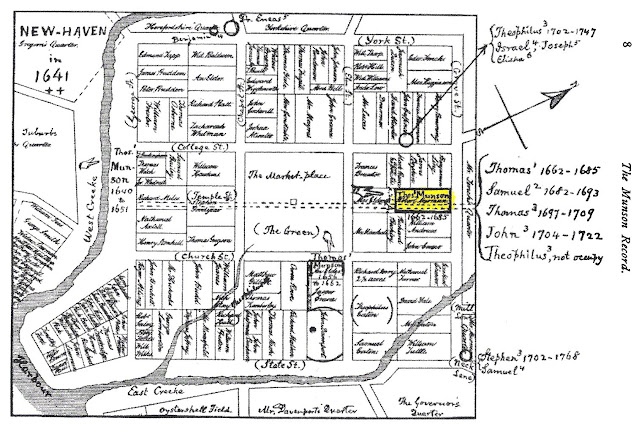My great-great grandmother Mary Jane Munson Smith was part of an absolutely gigantic family of
 |
| Munson's signature of the founders of New Haven is fifth down on the left |
Munsons that started with Capt Thomas Munson, the first emigrant. Munson came originally from Rattlesden, England and became one of the founders of New Haven, Connecticut.
"The first appearance of Thomas Munson (1612-1685) in America is recorded in Hartford, Connecticut in 1637 as a member of the militia unit engaged in the Pequot Indian War. He signed the Fundamental Agreement at New Haven Colony (dated 1639) prior to April 1640 and established his permanent home. His life and actions are well documented in The Munson Record, Volume I and the Connecticut colony records.
The evidence is persuasive that the Thomas Munson who was recorded as being baptized in St. Nicholas Church in Rattlesden, County Suffolk, England on September 13, 1612, was the same man who later distinguished himself in the public affairs of colonial New Haven. The principal tie is the age listed on his gravestone… aged 73 years, which links well with the baptismal record.
The Church records document that the Thomas Munson of Rattlesden was the son of John and Elizabeth Munson. John was baptized 14 October 1571 and was buried 26 November 1650. Elizabeth was buried 3 January 1634/5. John was the son of Richard and Margery (Barnes) Munson. Richard was buried at Rattlesden on 3 December 1590, while Margery was buried there 7 February 1622/3. (The Munson Family of County Suffolk, England, and New Haven, Connecticut, Milton Rubincam, The American Genealogist, January 1941.) Thomas Munson of Hartford and New Haven married Joanna. This marriage produced 3
children (generation 2): Elizabeth, Samuel, and Hannah. Generation 2 produced 19 generation 3 descendants (grandchildren of Thomas and Joanna); Generation 3 produced 66 great-grandchildren of Thomas and Joanna (generation 4).
From the beginning of TMF, a “Clan-based” structure was recognized. Originally, each TMF Clan was understood to consist of all identified linear descendants of Thomas and Joanna through male lines; as Clan Head was the great-grandson in that line; the Clan bore his Name. 17 such Clans were recognized. Obviously, many lines from Thomas and Joanna were overlooked in this structure: the descendants of Elizabeth (generation 2) and Hannah (generation 2) as well as all the female lines in later generations. In 2008, TMF broadened the definitions to recognize descendancy traced through all the great-grandchildren of Thomas and Joanna. Thus were identified as many as 43 potential new Clans. To date, descendants in 7 of these have been located and their new clans have been activated. Listed on this website is the current list of 24 Clans."
The early Munson's lived in New Haven. Here's a neat image of where the early Munson's lived in town:
I am from Clan William. I have purchased the first two volumes of The Thomas Munson Genealogy and though Clan William is completely left out of Vol II, enough information was available in Vol I to help keep my efforts going. Clan William seems to have a lot of people who moved West early on, which could account for the genealogy not being able to keep up with their movements while Vol II was being prepared. I'm awaiting Vols III-V to see where I've gotten it right/wrong/or where the genealogy document needs some help.
There are well over a million living descendants of Thomas Munson living in the US today. Wow!









































